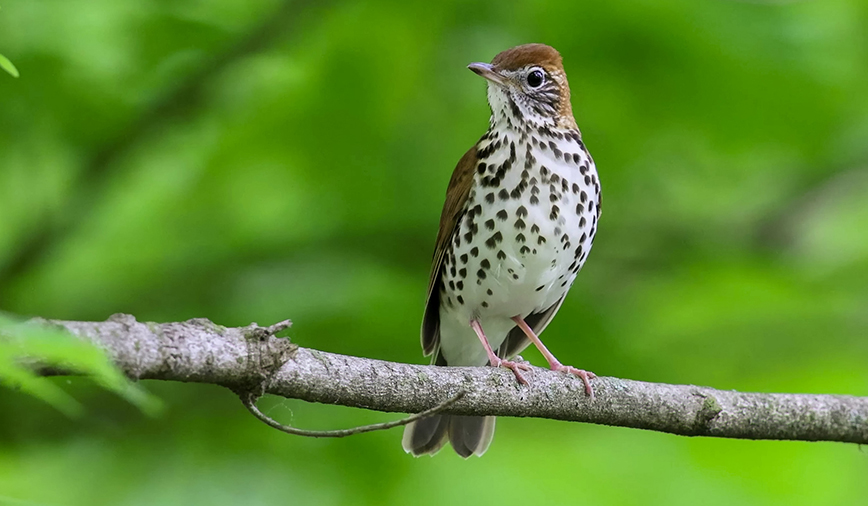June 5, 2015
Wood Thrush
The wood thrush’s scientific name, Hylocichla mustelina, is derived from the Greek words for woodland, thrush and weasel—the last word perhaps referring to the bird’s reddish brown coloration. Look, and listen, for wood thrushes in habitat that includes mature trees, leaf litter for foraging, and a nearby source of fresh water.
Beguiling. Alluring. Haunting. These are just a few of the words that have been used to describe one of our most intriguing seasonal songsters, the wood thrush.
Neotropical migrants, wood thrushes visit our area from May to September. We offer them deciduous woods with dense understories, areas they consider excellent habitats for raising a family; in return they eat our ants, caterpillars and other crawly critters, and dapple our woodlands with sweet summer song.
The wood thrush is a cousin of the American robin, an accomplished singer in its own right. But whereas the robin repeats its song over and over – and over
– the wood thrush metes its notes out more sparingly. A quiet jingle here, a pause, then an echoing refrain over there.
Field guides attempt to describe the sound and use words such as “po-popo” and “whee-do-lay,” but that’s a little bit like saying the 1812 Overture goes “da-da-da-da-da-da-da da da.” The best way to know what a wood thrush song sounds like is to hear it yourself.
There’s just something about the wood thrush’s lilting, flute-like song that draws you in. Like the Pied Piper, it beckons you to follow. And on Thursday evening, I did.
We were at LeRoy Oakes for a night-time session of summer nature camp, and I had a few extra minutes while building the campfire the kids would use to roast marshmallows. (I also had to take evasive action; the Hershey bars we’d brought for s’mores were exerting their own powerful influence, and if they disappeared I knew there’d be heck to pay later.) So off into the woods I went.
The song was coming from a nearby stand of oaks surrounded by a thick understory of honeysuckle, buckthorn and prickly ash. I looked around, a lot, but masses of leaves effectively camouflaged the persistent performer. No matter. The merry melody, repeated every minute or so, left little doubt of what bird was in the branches above me.
Oddly enough, it was just that morning, also at Leroy Oakes, that I’d stopped to watch the antics of one of the wood thrush’s biggest banes – the brown-headed cowbird. Cowbirds are brood parasites, that is, they lay their eggs in other birds’ nests. And wood thrushes are a favorite target.
That morning, two pairs of cowbirds were foraging near the pavilion at Leroy, the avian equivalent of empty-nesters enjoying a lasting freedom from any parental responsibilities. That night, as I listened to the thrush declaring its territory, I couldn’t help but wonder if its nest had been visited by either pair of the presumptuous pests.
Wood thrushes have other threats as well, primarily deforestation in their winter homes in Central America. Though they have no special status here in Illinois, wood thrush populations in general have declined by an estimated 43 percent since 1966 and are listed on the Audubon Watchlist as a species of concern.
Efforts are underway to protect the wood thrush’s habitat, both here and far away, and it’s hoped that this decline can be reversed. Which is good news for those of us who can’t bear the thought of a summer without wood thrushes.
Apparently Henry David Thoreau was just as nuts about these birds as I am. Listening to a wood thrush at sunset, he wrote, “It is not so much the composition of the strain, the tone that interests us – cool bars of melody from the atmosphere of everlasting morning and evening. It is the quality of the sound, not the sequence. In the pewee’s note there is some sultriness, but in the thrush’s alone declares the immortal wealth and vigor that is in the forest.”
Wow. Immortal wealth and vigor, in addition to beguiling, alluring and haunting. The wood thrush has it all. Hope you can head out and hear one soon.
Pam Erickson Otto is the manager of nature programs and interpretive services at the Hickory Knolls Discovery Center, a facility of the St. Charles Park District. She can be reached at 630-513-4346 or potto@stcparks.org.

